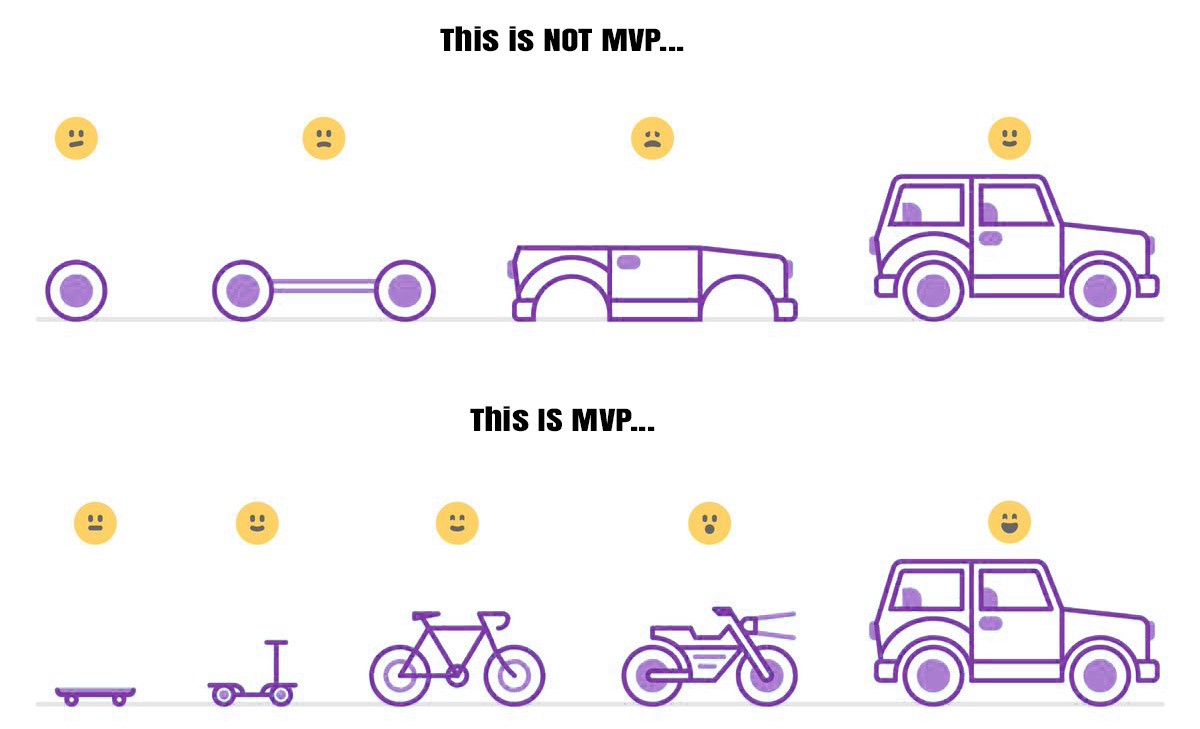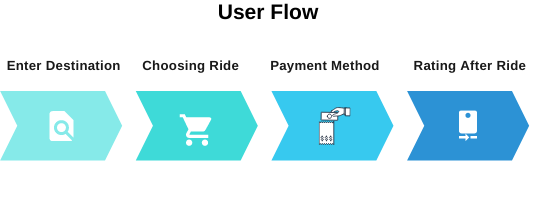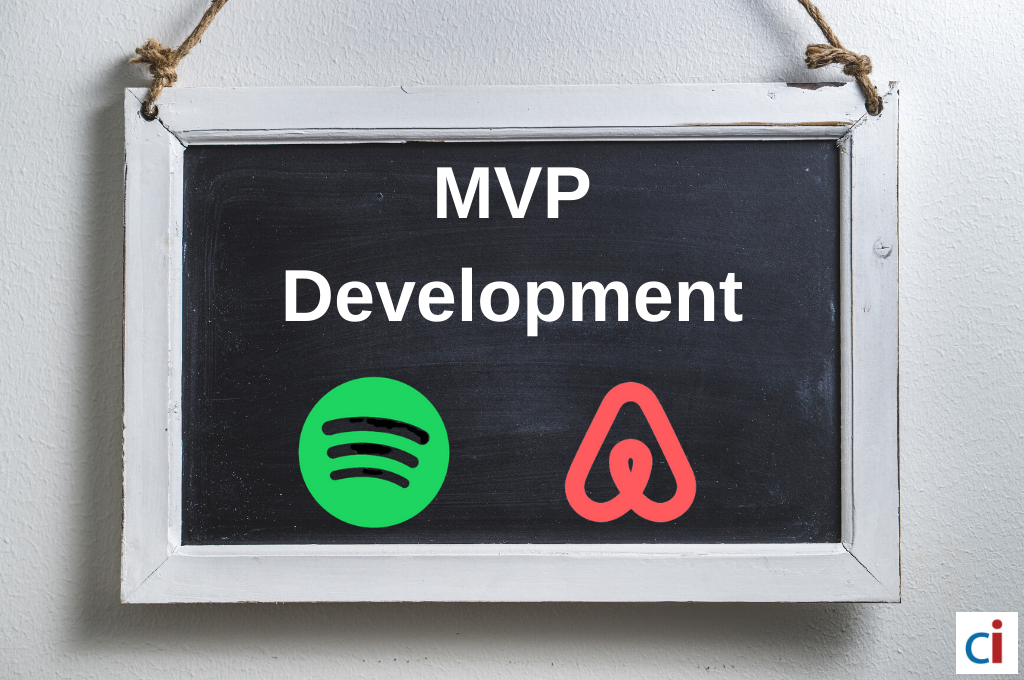Taking the MVP approach to launch an app is a proven route to success. Airbnb, Uber, Facebook, Spotify, Buffer, Amazon, and various apps that the majority of us have on our smartphones started out as minimum viable products (MVP).
This approach enabled these startups to become success stories and cease the market when the time was right. Their idea was new and they did not waste time polishing the product. They just presented their idea in a raw format and are still working to perfect it as per user feedback.
Airbnb launched as a basic website, Uber started with just a black limo service, Facebook acted as a directory limited to Harvard students, Buffer was just a two-page site launched with a tweet. Most startup stories start with a minimum version of a product that required validation. Once validated, the owners kept building the product, adding more features, and expanding the market.
No wonder, most entrepreneurs with a startup app idea take the MVP route. If you are also one of them, here is all you need to know about building MVP for app startup and everything that goes into it.
The Approaches To Build An MVP
There are several approaches that are being used to launch an app. These are about the way they define an MVP or the first version of the startup app. For many, the first version could be just a visual diagram explaining the features & benefits while for others, it could be the completely finished version. Here are different approaches that you can take to build your app MVP.
No Product MVP
This is where you seek validation for your idea with just the visualization. There is no coding involved in this approach as you do not build anything. You create diagrams, share research studies, blogs, videos, etc., to get validation on the idea before you start with the product development.
Product Mockup
The next approach that many app startups take to build their MVP is to build a product mockup. This is nothing but a simple mockup of the idea that they have without using any complicated or advanced technologies.
Single Feature MVP
One of the most popular approaches taken by startup apps to build an MVP is to have a single feature app first. This means they build the MVP with the core feature and the rest of the features are added in the later versions.
MLP
An MLP is the Minimum Loveable Product that has the minimum offerings to make the customer love the product. This means that the first version of the app should have the basic requirements to make someone love it instead of simply tolerating it in the first use.
EVP
EVP stands for an exceptional viable product. This is one approach that not every company aspires to but only a few take it. This is when you start with the most polished version of your app. Your app development team spends time perfecting the product to ensure that it is able to entice the early adopters in the very first version with an exceptional experience. There is a stark difference between an MVP and an EVP owing to the finishing of the product.
Prototype
This type of startup app is a model of the app but does not have any features added to it. This prototype helps startups envision their MVP and acts as a base for the same.
The Right Way To Build An MVP
Many people think that taking that MVP route means offering the simplest version of the product without considering its importance. This is where most go wrong. The crux of building an MVP is that it should be built in such a way that solves an issue or fills a gap prevalent in the market. However, many companies have failed in their efforts to building the MVP. This is because they took it the wrong way. Let’s understand this ‘wrong way’ to MVP development first before finding ought the right way.
Many companies think that because MVP means building the minimum viable product, they can offer the bare minimum. They build a first version that does not offer anything to the user. In some cases, this first version is not even a working prototype that could reflect what the main product would be about.

Source: UxDesign
What Goes Wrong?
While startups focus on the minimum part of the MVP, they forget about the viable part. This word holds immense importance in taking the MVP approach. What goes wrong is that they try to build something so minimum that it loses any/all importance.
The Right Way
The only right way to build an MVP is to delight the users at the very first use. This does not mean that you offer the totally finished product at the very start. But this means that you offer an app that has the required features or the core offering of the app idea that you are selling. You should start small but make sure the app is solving the main problem and helping the users in some way.
For example, a ride-booking app like Uber should have an MVP where it enables people to book a ride. Once this idea gets a green light flag from the users, it can move ahead and add other features like ride-sharing, invitations, multiple payment options, etc., in the next versions.
Also Read: Why Startups Need MVP?
The first version itself should be a completed product. It could be unfinished with a subpar user experience. But there should be no compromise with the core offering of the app.
Resources That Go In Building MVP App
Building anything requires labor and this is the first thing that one should analyze. Similar to building any other digital product, MVP development requires a team of developers, designers, managers, and quality analysts. You can either hire remote developers or freelancers for your team, build a dedicated team for the MVP, hire in-house experts, or outsource MVP development to an external product development company.
Hire Remote App Developers/Team
In this approach, startups look for remote workers like the UI/UX designer, front-end/back-end developers, QA analysts, technology experts, etc. for building the MVP. You can hire remote developers or even build dedicated remote teams for MVP development from offshore companies. Not just that, you can also hire developers as an extension to your in-house team.
Outsource MVP Development
The next approach for MVP development is to outsource it to a company offering you to outsource software development. This is where you get end-to-end MVP development services. In such a proposition, the company takes care of everything from ideation to market research to development and launch. Joining hands with an MVP development company saves a lot of time and money when startups decide to outsource MVP development.
-1.png?width=700&name=ProductDev-Process-img%20(1)-1.png)
Build In-House MVP Development Team
Another common approach to MVP development is via an in-house team. You need to set up the complete team and manage their IT infrastructure while also ensuring security. It could be cost excessive and increase the overall budget of building the MVP.
Cost That Goes In Building MVP App
When we talk about what goes into building an MVP app, the first question will always be around the cost that goes in. So, let’s quickly analyze the cost of building an MVP app for startups.
As we discussed above, building an MVP app requires a small team - a mid-level developer, a junior developer, a UI/UX designer, a quality analyst, and a manager. While the major cost of building an MVP app goes into the salary and fees of the team that you hire, let’s understand this by breaking the costs into the following:
Building the App (Development Cost)
These are the major costs. These include the cost of getting the MVP app built. You can choose either of the three approaches discussed in the above section to build the MVP app. Here is how much each of them would cost:
Hiring Remote Developers/Teams: The cost of hiring remote developers from countries like India reduces the cost by a large margin. You could get the entire MVP app built by them for as low as $38,100.
In-House MVP Development: For a startup, there is not a very big team sitting around waiting for instructions to start building something. They need to build a complete team. Hence, the cost of in-house development goes high and can come to around $178,770 as per our calculations.
Outsource MVP Development: One of the most popular practices among startups is to outsource their MVP app to a trusted external team. This is cost-effective as well as expertise and experience to their new team. The cost of outsourcing comes around $38,100.
We have a complete blog on calculating the MVP development cost in 2021 where you can see how we calculated these costs. If you also wish to calculate the costs of building your MVP app based on the complexity, technology, and other factors, this blog will help you do that in a simple manner.
Steps That Go In Building An MVP App
There are different steps that are involved in building a minimum viable product. Unlike app development, the actual development doesn’t take a lot of time at this stage. However, the initial research, ideation, market analysis, customer study, etc., takes up a majority of the time. There are some important steps that go into the building of an MVP app for startups. Let’s check them out.
#1. Market Research
The first step that goes into building an app MVP is market research. Almost 42% of startups fail because their app idea has no market need. No wonder there is a pressing need for every startup to perform in-depth market research before initiating the development process or investing any resources.
This is where you get validation for just your idea through research. You read research studies, go through different videos/blogs, conduct surveys, etc., to know if anyone is actually in need of the product/service you are planning to provide. In order to do the complete research, here is some question you find answers for:
-
What is the main problem this app will solve?
-
Who will like to use your app?
-
Will the target audience or the buyer persona you create be actually willing to pay for it?
-
Is there a similar app already existing in the market? What makes your app different?
-
What is the main USP of the MVP app that will make it stand out?
#2. Brainstorming Around the Idea
While you have performed the market research and know that there could be a market need for your startup MVP app, the next is to validate the idea. This is where you think about the product USP and analyze what would make it actually stand out.
The answers you find in the previous step play a crucial role in brainstorming. Here, you also need to analyze the answers to ensure you are on the right track. This step will help you find assurance and validity around your app idea.
#3. Outline The User Flow
Every app has a user flow that tells about the path a user will take upon entering the app. In this step, you will have to map the perspective and create the journey. Here, you visualize the product from the user’s perspective. This will tell you more about the way the user will enter and navigate the app.
Let’s understand this better with the help of an example. For example, you are building a ride-booking app like Uber. The initial MVP would have a user flow with steps including entering the destination name, finding the ride, booking the ride, making payment.

This would be the basic user flow in the initial MVP. And this will help determine the way you want to build your MVP app. To better understand this, outlining user flow means explaining the steps a user will take to reach the main objective of the app. In our example, booking a ride and making payment.
You need to analyze your app idea or the business model that you are following. Once that is done, you can easily know what actions you want the users to take upon entering the app. This step will help determine what pages to create and what type of buttons to add for navigation.
#4. Define & Prioritize MVP Features
Once the user flow has been established, you need to start defining and prioritizing the features of the first version. This is one of the most important steps.
To do this, one needs to start by enlisting all the features that would go in each step. This way, you will end up with a larger list of features to be put in the app. However, this list can be exhaustive. You need not put in all the features in the very first version. This is where prioritizing the features come in. You need to start by categorizing the features as core features and add-ons. You can follow the process shown in the image below to start prioritizing.
.png?width=536&name=MVP%20development%20guide%20(13).png)
You will end up with a list of the features that are absolutely necessary for the MVP app. These will be the features with the highest priority and impact in the app.
#5. MVP Development
Now that you know the user flow as well as the features required in each step, it is now time to assemble the MVP. This is where the complete development process starts. They should start by narrowing down the technology used and move ahead with assigning developers their jobs for building the prototype.
Also Read: Startup Dilemma: In-House Vs. Outsourced Product Development
There are different approaches that a startup can take to build its minimum viable product. Depending on the cost availability, technology requirements, and expertise in-house, startups can choose from the three approaches to MVP development. These are:
-
Hire remote developers/ teams
-
Build in-house MVP app development team
-
Outsource MVP development to a mobile app development company
#6. MVP App Launch
The next important step for building an MVP is the launch. When it comes to app MVP, it is important to analyze the platform where you plan to launch. This is where you need to choose the right platform for your MVP app launch.
As it is an MVP, you need to ensure that it need not be available for all platforms like iOS, Android, iPad, etc. It can be easily started for just one platform. So, you need to ensure which platform you have developed your app MVP for and prepare for the launch.
.png?width=536&name=MVP%20development%20guide%20(11).png)
Make sure you have created the marketing copies for promoting the MVP app launch and it is specifically targeted at the user personas of the early adopters.
#7. Measure, Learn & Implement
The post-launch period is very crucial for any MVP app. In fact, this is where the main essence of taking the MVP approach lies. You build the MVP, measure the success, learn from the feedback received, and implement it in the next versions or updates. Here are some of the ways to track the performance of your MVP app:
Feedback: This is where you collect feedback from the early adopters by questioning them about their experience.
Engagement: This is where you check the engagement level, time spent, the path they take, clicks they make, etc., to know how engaged they were with the MVP app.
Sign-ups: These are the number of people that sign up for your app via the platform you have launched on. This should be different from the Alpha tester (family & friends) that you ask to sign up.
Active Users: Check for the daily active users and monthly active users to know how many people are actively using your app.
Churn Rate: This is a very important measure to check the number of people still using the app MVP and the number of people who have uninstalled it.
Getting Started to Build The MVP
Now that you know everything that goes into building an MVP, it’s time to pug your idea into motion. You can choose the appropriate approach for building your MVP app. Analyze your idea, know the resources required and the costs that you will need. Once you have everything ready, you can start with the development part.
One of the shortest ways for startups to build a minimum viable product fast is to join hands with an app development company. They add the experience and expertise required for a new-age startup. Moreover, they will assist you in every step of the development. Right from the market research and ideation phase of MVP app development to building the team for the process and the actual development of the app and launch, they will put in their best in everything.
At Classic Informatics, we have assisted hundreds of startups with their app development. You can share your app idea with us and we can initiate the process within a few days. We will discuss the best technology, help you build the team, and get started with the development. It usually takes between four and eight sprints to completely build an MVP, depending on the complexity of the app. Nonetheless, we ensure speedy development to help you get your idea out in the market faster.













.png)










